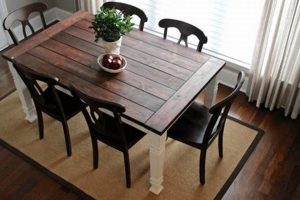A shop-built routing platform provides woodworkers with enhanced precision and control when shaping and profiling wood. This construction typically involves a stable, flat surface with an opening to accommodate a router, enabling upside-down operation. For instance, a user can create intricate molding details or smooth, consistent edges on workpieces by guiding them across the router bit.
Constructing one’s own specialized workstation offers significant advantages, including customization tailored to specific project needs and budget constraints. Historically, this approach has allowed craftsmen to bypass the expense of commercially manufactured units, while simultaneously achieving superior results. Furthermore, this practice encourages a deeper understanding of woodworking principles and tool functionality.
The subsequent sections will delve into the essential components, design considerations, and construction techniques involved in building a fully functional and safe routing workstation. These areas include a guide to selecting appropriate materials, incorporating effective dust collection, and implementing crucial safety features.
Essential Construction Considerations
The following guidelines provide critical insights for achieving optimal performance and longevity in a shop-built routing workstation.
Tip 1: Material Selection is Paramount: Opt for high-density materials such as MDF or phenolic plywood for the tabletop. These materials offer superior flatness and dimensional stability, crucial for accurate routing operations. Avoid materials prone to warping or expansion due to moisture.
Tip 2: Implement a Robust Fence System: A well-designed fence provides essential guidance and support during routing. Construct a fence from rigid materials and incorporate micro-adjustment capabilities for fine-tuning its position relative to the router bit. Ensure the fence is easily clamped and secured to the table surface.
Tip 3: Prioritize Effective Dust Collection: Routing generates significant amounts of airborne dust, posing health risks and reducing visibility. Integrate a dedicated dust collection port beneath the table, connecting it to a suitable dust collector or shop vacuum. Supplement this with an over-the-fence dust collection system for maximum efficiency.
Tip 4: Incorporate a Secure Router Mounting System: The router must be firmly and safely mounted to the table. Utilize a commercially available router plate or fabricate a custom mounting system that ensures the router remains securely in place during operation, minimizing vibration and potential hazards.
Tip 5: Include a Power Switch within Easy Reach: Integrating a readily accessible power switch allows for immediate shut-off of the router in emergency situations. Mount the switch in a prominent location on the table, ensuring it is easily activated while maintaining a safe operating stance.
Tip 6: Design for Adjustability and Future Expansion: Consider incorporating features that allow for future modifications or additions. This could include T-tracks for attaching accessories, adjustable leg levelers to accommodate uneven floors, or provisions for mounting a miter gauge for angled cuts.
Tip 7: Emphasize Accurate Measurements and Assembly: Precise measurements and careful assembly are fundamental to achieving a functional and safe workstation. Double-check all dimensions, ensure all components are square and properly aligned, and use appropriate fasteners to create a rigid and stable structure.
Adhering to these considerations will result in a routing platform that enhances precision, safety, and efficiency in a woodworking environment. Neglecting these aspects may compromise the quality of work and pose potential safety hazards.
The ensuing sections will provide detailed instructions for constructing a routing workstation, incorporating these essential tips and addressing potential challenges encountered during the building process.
1. Tabletop Material Selection
The selection of materials for the tabletop is a foundational element in the design and construction of a shop-built routing platform. The tabletop provides the stable and flat surface against which workpieces are guided during routing operations. Inadequate material choice can lead to dimensional instability, vibration, and compromised accuracy, ultimately impacting the quality of the finished product. For example, using solid wood without proper sealing can result in warping due to changes in humidity, making precise routing difficult or impossible. The relationship between material selection and the overall functionality of the finished unit is direct and significant.
Materials commonly employed include medium-density fiberboard (MDF), phenolic plywood, and occasionally, solid hardwood. MDF presents a cost-effective option with a smooth, uniform surface, but it is susceptible to moisture damage. Phenolic plywood offers superior durability and resistance to warping, making it a preferred choice for long-term reliability, despite its higher cost. Hardwoods, if properly sealed and finished, can provide a durable and aesthetically pleasing surface, but require careful attention to seasonal wood movement. Each materials properties directly influence the functionality, longevity, and precision of the complete workstation. A substandard tabletop can introduce errors that are impossible to correct during the routing process.
In conclusion, thoughtful tabletop material selection represents a critical step in constructing a shop-built routing workstation. Factors such as cost, durability, moisture resistance, and flatness must be carefully weighed to ensure optimal performance and longevity. An informed decision, considering the specific needs and environment of the woodworking shop, will contribute significantly to the overall accuracy and efficiency of the routing process, minimizing potential frustrations and enhancing project quality. Neglecting this aspect introduces inherent limitations that can undermine the utility of the entire system.
2. Fence System Rigidity
The rigidity of the fence system is paramount to the accuracy and safety of operations performed on a shop-built routing platform. A stable and unyielding fence provides a consistent reference surface, allowing for precise control over the material being routed. Any flex or movement in the fence translates directly into inaccuracies in the cut, compromising the intended result.
- Impact on Cut Accuracy
A flexible fence introduces inconsistencies in the cut depth and profile. For instance, when routing a groove, a fence that bows under pressure will result in a wider or shallower groove than intended. This problem becomes increasingly pronounced when working with larger or heavier workpieces that exert greater force against the fence. The potential for cumulative errors increases with each pass, making precise work extremely challenging.
- Material Selection and Construction Methods
The materials and construction techniques employed directly influence the fence’s overall rigidity. Solid hardwoods, reinforced plywood, and metal are common choices. Utilizing robust joinery methods, such as mortise-and-tenon or rabbet joints with adhesive and mechanical fasteners, strengthens the fence structure. Integrating reinforcing elements, like metal stiffeners, can further enhance its resistance to deflection. A well-constructed fence minimizes the effects of vibration and applied pressure during routing.
- Clamping Mechanisms and Stability
The clamping mechanisms securing the fence to the table surface are crucial to maintaining its rigidity. Inferior clamping systems that allow for movement or slippage negate the benefits of a well-constructed fence. Cam clamps, T-track systems with secure knobs, or robust lever-action clamps are preferred methods. Even distribution of clamping force along the length of the fence minimizes localized stress points that could induce flexing.
- Relationship to Router Bit Selection
The size and type of router bit used significantly impact the forces exerted on the fence. Large diameter bits or those used for aggressive material removal generate substantial vibration and lateral pressure. A rigid fence is essential to counteract these forces, preventing the bit from wandering or chatter from occurring. When using larger bits, consider reducing the depth of cut and making multiple passes to minimize the stress on the fence and ensure a clean, accurate cut.
In summary, the rigidity of the fence system is not merely a desirable attribute, but a fundamental requirement for achieving precise and safe routing operations. Careful consideration of material selection, construction methods, clamping mechanisms, and the interplay with router bit selection is essential when building a shop-made routing workstation. A robust and stable fence ensures accurate cuts, reduces the risk of errors, and enhances the overall quality of the finished workpiece.
3. Dust Collection Efficiency
Effective dust collection is a critical consideration in the design and implementation of a shop-built routing platform. The process of routing wood generates substantial airborne particulate matter, posing health risks and diminishing visibility. Integrating a robust dust collection system directly enhances the safety, cleanliness, and precision of routing operations.
- Health and Safety Implications
Wood dust is a known respiratory irritant and potential carcinogen. Prolonged exposure can lead to respiratory illnesses and allergies. Implementing efficient dust collection minimizes the inhalation of these particles, safeguarding the health of the operator. This is particularly relevant in enclosed workshop environments where airborne dust concentrations can quickly reach hazardous levels. Dedicated dust extraction is not merely a convenience, but a fundamental safety measure.
- Visibility and Accuracy Enhancement
Airborne dust obscures the workpiece and the router bit, hindering accurate routing. Reduced visibility increases the risk of errors and potential injury. An effective dust collection system removes dust at the source, providing a clear line of sight and allowing the operator to maintain precise control over the routing process. This improved visibility translates directly into increased accuracy and reduced instances of material waste or rework.
- Dust Collection Port Design and Placement
Optimal dust collection requires strategic placement and design of dust collection ports. A port located directly beneath the table, connected to a dust collector or shop vacuum, captures the majority of dust generated during routing. Supplementing this with an over-the-fence dust collection system further enhances efficiency by capturing dust expelled from the top of the workpiece. The port should be sized appropriately to accommodate the airflow requirements of the dust collection system.
- System Components and Compatibility
Effective dust collection relies on compatible components. A dust collector with sufficient CFM (cubic feet per minute) airflow is essential for capturing and removing dust particles. The diameter of the hose connecting the dust port to the collector must be appropriately sized to minimize airflow restriction. Furthermore, airtight connections are crucial to prevent loss of suction and maximize the efficiency of the system. Selecting compatible and properly sized components ensures optimal dust extraction.
Integrating efficient dust collection into the design of a shop-built routing platform requires careful consideration of health and safety implications, visibility enhancement, port design, and system component compatibility. A well-designed and properly implemented system significantly improves the working environment, enhances routing accuracy, and protects the health of the operator. Conversely, neglecting dust collection poses significant risks and compromises the overall quality and safety of the routing process.
4. Router Mounting Security
Router mounting security is a crucial aspect of the shop-built routing workstation. The method by which the router is affixed to the table directly influences the stability, safety, and precision of all subsequent routing operations. A poorly secured router can lead to vibration, inaccurate cuts, and potential hazards.
- Plate Material and Thickness
The router mounting plate, often constructed from phenolic, aluminum, or thick acrylic, provides the interface between the router and the table surface. The material’s inherent strength and dimensional stability are critical. Insufficient thickness or inadequate material properties can result in flexing under the router’s weight and operational forces, leading to inaccuracies. Thicker plates generally offer improved stability and vibration dampening.
- Mounting Hardware and Fastener Selection
The type and quality of fasteners used to secure the router to the mounting plate are significant. Countersunk machine screws, typically with flat or button heads, are commonly employed. Proper thread engagement and tightening torque are essential to prevent loosening due to vibration. Consideration should be given to using thread-locking compounds to further enhance security. The fastener material itself (e.g., steel, stainless steel) impacts its resistance to shear and tensile forces.
- Router Base Compatibility and Support
The router base must be compatible with the mounting plate. Some routers have standardized mounting hole patterns, while others require custom drilling or modification. The mounting plate should provide adequate support for the router base, distributing the weight evenly and preventing localized stress concentrations. Shim material may be required to ensure a flush and level interface between the router base and the mounting plate.
- Vibration Dampening Strategies
Vibration during routing can degrade cut quality and potentially loosen mounting hardware. Incorporating vibration-dampening materials, such as rubber washers or adhesive pads, between the router, the mounting plate, and the table surface can mitigate these effects. These materials absorb vibrational energy, reducing resonance and improving overall stability. Careful balancing of the router’s armature is also essential for minimizing vibration.
Router mounting security encompasses a range of interconnected factors, all contributing to the overall performance and safety of the constructed workstation. Compromising on any of these aspects can lead to degraded performance or even hazardous operating conditions. Therefore, meticulous attention to detail during the design and construction phases is crucial for a secure and reliable routing platform.
5. Switch Accessibility
Switch accessibility represents a critical safety component of any shop-built routing platform. The ability to quickly and easily deactivate the router in emergency situations mitigates potential risks associated with high-speed rotating cutters. The placement, type, and operational characteristics of the power switch warrant careful consideration during the workstation’s design and construction.
- Ergonomic Placement
The power switch should be positioned within immediate reach of the operator while maintaining a stable and balanced stance. Avoid placements requiring excessive reaching or awkward movements. The switch should be readily locatable by touch, enabling activation without visual confirmation. For example, a large, paddle-style switch mounted directly to the front of the router table allows for swift actuation with either hand or even a knee in emergency scenarios.
- Switch Type and Functionality
A heavy-duty, easily identifiable switch is paramount. Toggle switches are commonly used, but paddle switches or large push-button switches offer improved accessibility and ease of operation. The switch should be clearly labeled to indicate on/off status. Consider incorporating a switch with a lockout feature to prevent accidental activation during bit changes or maintenance. A clearly defined and easily operated switch minimizes confusion and reaction time in critical situations.
- Electrical Safety Considerations
The switch and its wiring must comply with relevant electrical codes and safety standards. Employ appropriately rated wire and connectors to handle the router’s amperage draw. Enclose the switch and wiring within a protective housing to prevent accidental contact with live components. Grounding the metal chassis of the router table, if applicable, further enhances electrical safety. Ignoring electrical safety protocols can lead to shocks or fire hazards.
- Integration with Dust Collection Systems
Advanced systems may integrate switch functionality with the dust collection system. A single switch can activate both the router and the dust collector simultaneously, streamlining operations and ensuring dust extraction occurs whenever the router is in use. Such integration requires careful planning and wiring to ensure proper functionality and electrical safety. Synchronized operation of the router and dust collector promotes a cleaner and safer working environment.
These facets of switch accessibility collectively contribute to a safer and more efficient routing experience. Prioritizing ergonomic placement, selecting appropriate switch types, adhering to electrical safety standards, and considering integration with dust collection systems are essential steps in building a functional and safe routing workstation. The accessible power switch is not merely a convenience; it is a critical safety device that can prevent accidents and injuries during routing operations.
Frequently Asked Questions
This section addresses common inquiries regarding the construction and utilization of a shop-built routing platform. The information provided aims to clarify potential concerns and optimize the performance of such a workstation.
Question 1: What is the minimum recommended thickness for the tabletop surface?
The tabletop surface should possess a minimum thickness of 3/4 inch when constructing a shop-built routing platform. Lesser thickness can compromise stability and increase the risk of vibration during operation.
Question 2: Which factors are most important when selecting a router for use within a table?
Key factors include variable speed control, soft-start functionality, and the presence of above-table adjustment capabilities. Variable speed allows for optimization based on bit size and material type, while soft-start reduces initial torque. Above-table adjustment significantly simplifies bit changes and height adjustments.
Question 3: How can vibration be minimized in a shop-built unit?
Vibration can be minimized through several methods. These encompass ensuring a stable base, using a heavy router mounting plate, and incorporating vibration-dampening materials between the router and the table surface. Careful bit selection and appropriate feed rates also contribute.
Question 4: Is a commercially manufactured router lift necessary for a shop-built application?
A commercially manufactured router lift is not strictly necessary, although it provides convenient above-table adjustment. Alternative methods, such as a basic mounting plate with shimming, can achieve similar functionality at a lower cost.
Question 5: What are the most effective methods for achieving accurate fence alignment?
Precise fence alignment is achievable through the use of precision measuring tools, such as dial indicators or digital calipers. Micro-adjustment mechanisms incorporated into the fence design further facilitate accurate positioning relative to the router bit.
Question 6: What safety precautions should be considered during operation?
Safety precautions include wearing appropriate eye and ear protection, ensuring proper dust collection, using feather boards and push sticks to maintain control of the workpiece, and disconnecting power before performing bit changes or adjustments. A readily accessible power switch is also essential.
This information clarifies key elements relating to the construction and safe operation of shop-built routing platforms. Adherence to these guidelines promotes accurate and safe woodworking practices.
The subsequent section will address advanced techniques applicable to such woodworking equipment.
Conclusion
This exploration has detailed the essential aspects of constructing a “diy router table,” emphasizing material selection, fence rigidity, dust collection efficiency, router mounting security, and switch accessibility. Each element directly influences the precision, safety, and overall utility of the finished workstation.
Proper application of these principles enables woodworkers to enhance their capabilities and achieve professional-grade results. Continuous improvement through thoughtful design and adherence to safety protocols remains paramount. The effective utilization of a well-constructed routing platform represents a significant advancement in woodworking practice.






![Build a Safe DIY Table Saw Push Stick [Guide] The DIY Hub: Creative Crafts, Repairs & Life Hacks Build a Safe DIY Table Saw Push Stick [Guide] | The DIY Hub: Creative Crafts, Repairs & Life Hacks](https://craftingdiycenter.com/wp-content/uploads/2025/07/th-4323-300x200.jpg)
